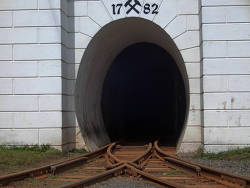Norsk Bergverksmuseum Kongsberg
Sølvgruvene - Kongens Gruve - Norwegian Mining Museum
Useful Information

| Location: |
Malmveien 11, 3614 Kongsberg.
From Kongsberg E134 south towards Notodden, exit Saggrenda, signposted. (59.630388, 9.600609) |
| Open: |
Museum: 18-MAY to 21-AUG daily 11-17. 22-AUG to 17-MAY Tue-Sun 12-16. Closed 24-DEC to 02-JAN. Mine tours: Mid-MAY to mid-JUN Mon-Fri 10, 12, Sat, Sun 12, 14. Mid-JUN to mid-AUG daily 10, 12, 14. Mid-AUG to AUG Mon-Fri 12, Sat, Sun 12, 14. SEP Sat, Sun 12, 14. OCT to mid-OCT daily 12. Online booking recommended. [2022] |
| Fee: |
Museum: Adults NOK 140, Children (6-18) NOK 80, Students NOK 110, Seniors NOK 110. Mine tours: Adults NOK 250, Children (3-15) NOK 140, Students NOK 200, Seniors NOK 200. [2022] |
| Classification: |
 Silver Mine Silver Mine
|
| Light: |
 Incandescent Incandescent
|
| Dimension: | |
| Guided tours: | V=40,000/a [2010]. |
| Photography: | allowed |
| Accessibility: |
Museum: yes. Mine: no |
| Bibliography: |
Museum:
self guided Mine tours: D=90 min. |
| Address: |
Norsk Bergverksmuseum, Hyttegata 3, N-3601 Kongsberg, Tel: +47-919-13-200.
E-mail: Norsk Bergverksmuseum, Postboks 18, N-3602 Kongsberg. |
| As far as we know this information was accurate when it was published (see years in brackets), but may have changed since then. Please check rates and details directly with the companies in question if you need more recent info. |
|
History
| 1623 | first silver discovered. |
| 1770 | Kongsberg second-largest town in Norway, more than 4,000 men employed at the Silver Mining Company. |
| 1844 | furnace built, which is now home to the museum. |
| 1938 | museum founded. |
| 1958 | silver mining ended. |
Description
The Norsk Bergverksmuseum (Norwegian Mining Museum) is a museum located in the center of Kongsberg, right at the rapids in the river. It shows various exhibits like tools, machinery, documents, and pictures of the local silver mining. Impressive is the Native Silver collection, some of the best silver specimens from the Kongsberg silver mines are on exhibit. The silver from Kongsberg is famous among mineral collectors. Different shapes of native silver as well as plate silver, massive silver and crystalline silver is on display. Other important minerals from the mine are gold, armenite, and heulandite-Ba. Armenite was named after Armen mine, close to the King’s mine, which is the type locale. Heulandite is more complicated, the was given by in 1822 by Henry James Brooke in honor of Johann Heinrich "John Henry" Heuland. But there are varieties with Ba, K, Na, and Sr. The Ba variety has its type locale at the Northern Ravnås Prospect near Kongsberg. But the mineral collection also contains a large number of other Norwegian minerals. The museum is definitely worth a visit and probably a good preparation for the underground tour.
There is also a very interesting exhibition on the Kongsberg Arms factory, which is famous for having developed and produced the Kongsberg colt and the Krag-Jørgensen rifle. They also produced wrenches and bicycles. Founded in 1814 it had a wide range of products and innovations, and is the basement of the modern high-tech companies of the city. The Kongsberg skimuseum is less mining related, but definitely worth a visit. The Mint Exhibition on the other side is obviously based on the mined silver, which was used to produce coins like Christian IV’s silver dollars (Rigsdaler)
About 5 km drive from the museum is the Sølvgruvene (silver mine) which is also part of the museum. Meeting point for the tours is the Sakkerhusene, with a cafe and museum shop. A mine train on an 800 mm gauge, pulled by diesel locomotives, brings the visitors 2,300 m into the tunnel of the Kongens Gruve (King’s mine). The show mine is located 342 m below the surface.
The high time of the silver mining was during the 18th century. In 1770 Kongsberg was the second-largest town in Norway. More than 4,000 men were employed at this time by the Silver Mining Company.
From the beginning for more than two centuries German mining engineers were employed. As a result many names are in German, for example the Gottes Hülfe in der Noth (God Help in Distress) mine, which is used for adventure tours. The tours through an undeveloped part of the mine require gum boots and a good lamp. The mine is also entered on the mine train, but the transport is 2.3 km long to the Christian VII’s adit. Here it’s a 1.2 km walk through undeveloped mine passages, then the ride back. These tours are available only for groups by appointment, in English and Norwegian.
- See also
 Search DuckDuckGo for "Norsk Bergverksmuseum Kongsberg"
Search DuckDuckGo for "Norsk Bergverksmuseum Kongsberg" Google Earth Placemark
Google Earth Placemark Kongsberg Silver Mines - Wikipedia (visited: 06-AUG-2020)
Kongsberg Silver Mines - Wikipedia (visited: 06-AUG-2020) Norwegian Mining Museum - Wikipedia (visited: 06-AUG-2020)
Norwegian Mining Museum - Wikipedia (visited: 06-AUG-2020) Sølvgruvene, official website (visited: 03-JUN-2022)
Sølvgruvene, official website (visited: 03-JUN-2022) Kongsberg silver mining district - mindat.org (visited: 03-JUN-2022)
Kongsberg silver mining district - mindat.org (visited: 03-JUN-2022)
 Index
Index Topics
Topics Hierarchical
Hierarchical Countries
Countries Maps
Maps